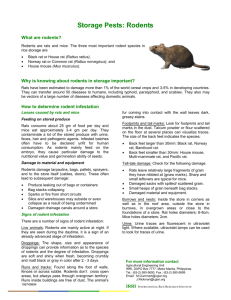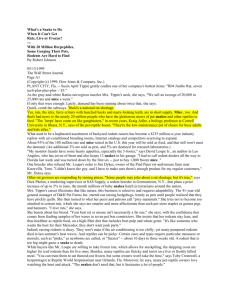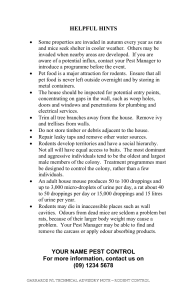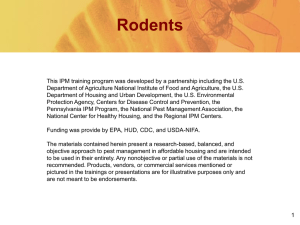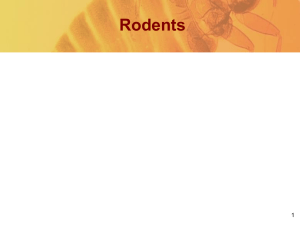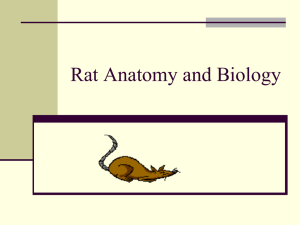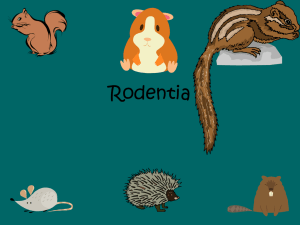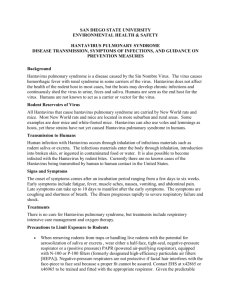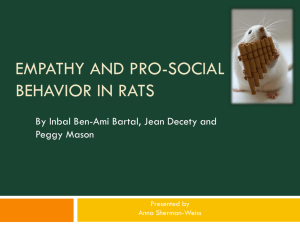Please click here to view presentation
advertisement
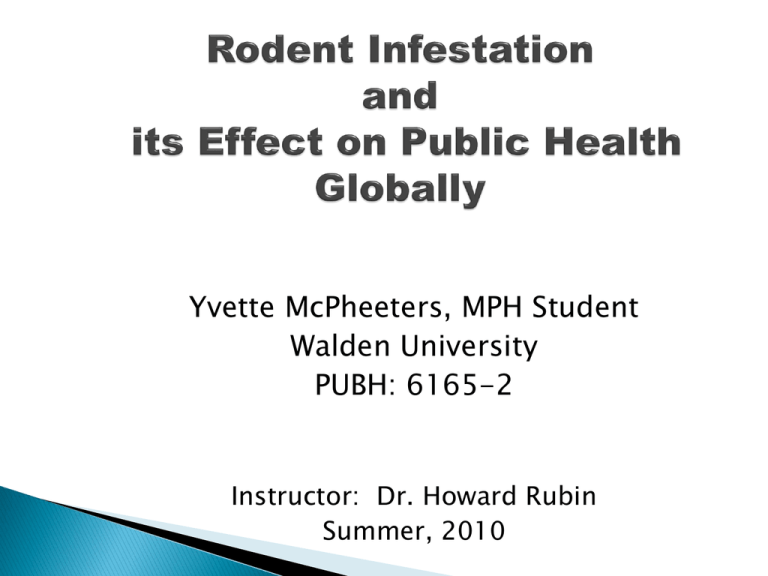
Yvette McPheeters, MPH Student Walden University PUBH: 6165-2 Instructor: Dr. Howard Rubin Summer, 2010 • Types of Rats and mice (vectors) • Diseases rodents carry • Number of disease cases • How rats and mice act in the environment • Environmental damages • Preventive measures Norway Rat (sewer rat) Roof Rat (black rat) House Mouse White-Footed Rat Cotton Rat Rice Rat Deer Rat http://www.cdc.gov/rodents http://www.animalcontrol.com.au/rodent.htm Childs et al. (1998) • • • • • • • • • Bubonic Plague (Black Death) Hantavirus Pulmonary Syndrome (HPS) Rat-bite fever Lassa Fever (Lassa virus) Leptospirosis Murine Typhus Tapeworms Favus, Ringworm Salmoncliosis http://www.cdc.gov/ncidod/diseases/hanta/hps/noframes/caseinfo.htm Frantz, & David, (1991) Childs, McLafferty, Sadek, Miller, Khan, DuPree, Advani, Mills, & Glass, (1998). WHO, (2008) Bonner, Schmidt, Belmain, Oshin, Baglole, & Borchert, (2007) Chou, Chen, & Liu, (2008) The Bubonic Plague Hantavirus Pulmonary Syndrome (HPS) Lassa Fever Leptospirosis Rat-Bite Fever www.cdc.gov/mmwr Bonner et al. (2007) Chou, Chen, & Liu, (2008) WHO, (2008) Childs et al. (1998) Diet Habitat Biology Physical Abilities http://www.animalcontrol.com.au/mice.5.htm Frantz & Davis, (1991) • Contact avoidance • Environmental hygiene practices • • • Take precautions to protect against household exposure to rats and mice Reduce rodent shelter and sources of food inside and outside the home environment Reduce exposure to rats and mice in the workplace www.cdc.gov/ncidod, (2002) Rats and mice are vectors These rodents carry over 35 different diseases Rat and mice exposure occurs worldwide Rodent activity leads to global infestation and causes global crop damage and economic loss Taking the necessary precautions can prevent exposure to rodent-borne diseases The National Center for Infectious Diseases, MMWR. (2002). Hantavirus Pulmonary Syndrome—United States: Updated Recommendations for Risk Reduction. 51(RR-9). Retrieved July 19, 2010 from http://www.cdc.gov/ncidod/diseases/hanta/hps/noframes/caseinfo.htm. Animal Control Technologies (ACTA). (2004). Rat Problems in Australia, Rat Infestation in Crops. Retrieved July 21, 2010 from http://www.animalcontrol.com.au/rodent.htm Animal Control Technologies (ACTA). (2010). Mouse Problems in Australia: Dealing with Mice Plagues. Retrieved July 21, 2010 from http://www.animalcontrol.com.au/mice5.htm Childs, J. E., McLafferty, S. L., Sadek, R., Miller, G. L., Khan, A. S., DuPree, E. R., Advani, R., Mills, J. N., & Glass, G. E. (1998). Epidemiology of Rodent Bites and Prediction of Rat Infestation in New York City. American Journal of Epidemiology. 148(1), 78-87. Retrieved July 19, 2010 from http://aje.oxfordjournals.org Bonner, P. C., Schmidt, W. P., Belmain, S. R., Oshin, B., Baglole, D., & Borchert, M. (2007). Poor Housing Quality Increases Risk of Rodent Infestation and Lassa Fever in Refugee Camps of Sierra Leone. American Journal of Tropical Medicine and Hygiene. 77(1), 169-175. Retrieved July 22, 2010 from http://www.cdc.gov Chou, Y. L., Chen, C. S., Liu, C. C. (2008). Leptospirosis in Taiwan, 20012006. Centers for Disease Control, Taipei, Taiwan. Emerging Infectious Disease Journal. 14(5). Retrieved July 21, 2010 from http://www.cdc.gov.eid/content/14/5/856.htm Makundi, R. H., Bekele, A., Leirs, H., Massawe, A. W., Rwamugira, W., & Mulungu, L. S. (2005). Farmer’s Perception of Rodents as Crop Pests: Knowledge, Attitudes and Practices in Rodent Pest Management in Tanzania and Ethiopia. Belgian Journal of Zoology. 135: 153-157. The World Health Organization (WHO): Regional Office for South-East Asia. (2010). Frequently Asked Questions on Plague. Retrieved July 21, 2010 from http://www.who.org. National Center for Infectious Disease: Special Pathogens Branch. (2006). All About Hantaviruses. Rodents That Carry the Types of Hantavirus Which Cause HPS in the United States: Photographs retrieved July 22, 2010 from http://www.cdc.hantaviruses.mht United States Environmental Protection Agency (EPA). (2010). “Rats Grow Fat and Happy, Thanks to Mild Sacramento Winters.” Retrieved June 22, 2010 from http://www.earthguardpest.com/blog/?tag=rat-infestation. Science Daily. (2009). Climate Change Threatens Rice Production. Research news report retrieved from www.newsdaily.com Howard University’s CapComm Lab, Earth Conservation Corps, and EPA. (2010). Educational video: “Infestations Vacations.” available online: www.epa.gov/pesticides/controlling/rodents.htm#video White, J. (2003). Habitat Manipulation and Rodent Damage Control: Reducing Rodent Damage in Australian Macadamia Orchards. Singleton, G. R., Hinds, L. A., Krebs, C. J., & Spratt, D. M., Rats, Mice and People: Rodent Biology and Management. Canberra: Australian Centre for International Agricultural Research (ACIAR), 213-216. Langton, S. (2001). The Occurrence of Commensal Rodents in Dwellings As Revealed by the 1996 English House Condition Survey. Journal of Applied Ecology. 38: 669-709. National Institute of Environmental Health (NIH). (2005). Association of Housing Disrepair Indicators with Cockroach and Rodent Infestations in a Cohort of Pregnant Latina Women and Their Children. Environmental Health Perspectives. 113(12). Document available: http://find.galegroup.com.ezp.waldenlibrary.org/gtx/retrieve.do?co ntentset=IAC-Documents. Gale document Number: A140487323 National Association of Realtors. (1996). I Thought a Saw a Rat: (Rat Control). Journal of Property Management. Document available online: http://find.galegroup.com.ezp.waldenlibrary.org/gtx/retrieve.do?co ntentSet=IAC-Document
